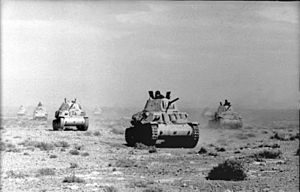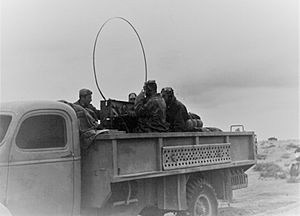Action at Bir el Gubi (November 1941) facts for kids
Quick facts for kids Action at Bir el Gubi (November 1941) |
|||||||
|---|---|---|---|---|---|---|---|
| Part of Operation Crusader during the Second World War | |||||||
 Italian M13/40 tanks in North Africa. |
|||||||
|
|||||||
| Belligerents | |||||||
| Commanders and leaders | |||||||
| Strength | |||||||
|
22nd Armoured Brigade
|
132nd Armoured Division Ariete
|
||||||
| Casualties and losses | |||||||
| 100 killed and wounded 32 captured 52 tanks destroyed |
95 killed and wounded 82 missing 12 guns lost 14 tankettes destroyed |
||||||
The Action at Bir el Gubi (November 1941) was a battle that took place on November 19, 1941, in Libya. It was one of the first fights in Operation Crusader during the Second World War. In this battle, the Italian armored forces won a key victory.
Contents
What Happened Before the Battle
The Plan for Operation Crusader
On November 15, 1941, General Claude Auchinleck of the British Eighth Army started a big plan called Operation Crusader. The main goal was to help the city of Tobruk, which was surrounded by German and Italian forces. The British also wanted to push the Axis army (Germany and Italy) out of Cyrenaica, a region in Libya.
The British plan was to send their 7th Armoured Division around the southern side of the German and Italian positions. Then, they would attack the forces that were surrounding Tobruk.
Axis Defenses
At the same time, German General Erwin Rommel was planning his own attack on Tobruk. He had gathered his troops near the coast, between Tobruk and the border with Egypt.
The Italian Ariete Division was given an important job. They had to defend a crucial road junction at Bir el Gubi. This spot was important because supplies for many places, including Tobruk, passed through it.
The Armies Involved
The Italian 132nd Armored Division "Ariete" was led by General Mario Balotta. They had about 130 M13/40 medium tanks. They also had infantry (foot soldiers) called Bersaglieri and artillery (big guns).
The British 22nd Armoured Brigade was led by Brigadier John Scott-Cockburn. They had about 150 Crusader tanks and some armored cars. They also had motorized infantry, artillery, and anti-tank guns.
The Battle at Bir el Gubi
Setting Up Defenses
On November 15, the Italian Ariete Division moved to the southern side because British forces were seen nearby. They quickly started building defenses. They set up strong points with Bersaglieri soldiers, supported by anti-tank guns and mortars. They continued building these defenses until November 18.
The British 7th Armoured Division split into three groups. One group went north to help another British army group. Another group headed towards Sidi Rezegh, where Axis air bases were located. The 22nd Armoured Brigade, on the left side, went towards Bir el Gubi. Their goal was to defeat the Ariete Division and then attack a German tank division from behind. British armored cars went ahead to scout the area.
November 18: First Contact
At 2:00 PM on November 18, British armored cars were spotted by Italian M13/40 tanks. The Italian tanks fired, but the faster British armored cars easily got away. As night fell, British planes bombed the Italian Ariete Division, hurting some soldiers and destroying a vehicle.
After learning about the British presence, General Balotta ordered his Italian division to get ready for defense. The Bersaglieri shortened their front line, and big gun trucks were placed north of Bir el Gubi. The Italian tank regiment moved to cover the road to El Adem, ready for any counterattacks.
November 19: The Main Fight
On the morning of November 19, the British 22nd Armoured Brigade moved towards Bir el Gubi, again with armored cars leading the way. Italian M13/40 tanks, supported by guns, attacked the armored cars and forced them to retreat. However, the Italian tanks were then attacked from behind by British Crusader tanks. The Italians lost three M13/40 tanks and some soldiers before retreating.
Around noon, the British armored cars saw the Italian Bersaglieri defense line about 4.5 kilometers south of Bir el Gubi. At 10:30 AM, the 22nd Armoured Brigade, with artillery support, advanced. British tanks quickly overran one Italian gun battalion that wasn't fully ready. Another group of Italian M13/40 tanks tried to help but was destroyed by the British.
However, some British tanks faced strong resistance from another Bersaglieri battalion. These Italian soldiers were well-dug-in and had artillery support, which stopped the British advance.
Some British tanks managed to break through the Italian lines, cutting off an Italian command post. The situation became very difficult for the Italian defenders.
Italian Counterattack
At 1:30 PM, the Italian 132nd Tank Regiment launched a counterattack. About 60 Italian tanks moved south to attack the British. These Italian tanks fought hard against the British regiments, eventually going around them and forcing them to pull back.
Another British tank squadron tried to go around the Italian Bersaglieri positions. But Italian anti-tank guns and gun trucks stopped them, causing heavy losses for the British.
The British 3rd County of London Yeomanry moved to help their comrades. They surprised some Italian tanks that had gone around the British line and quickly defeated them. However, this British force then ran into Italian anti-tank defenses, which quickly destroyed four tanks, including the one belonging to their commander.
By 4:30 PM, the British 2nd Royal Gloucestershire Hussars were forced to retreat under heavy fire from Italian tanks and anti-tank guns. The 4th County of London Yeomanry also pulled back. The 3rd County of London Yeomanry, which had fought less, was ordered to try another attack, but this order was canceled at 5:50 PM because of the losses they had suffered. The attack by the 22nd Armoured Brigade had completely failed.
What Happened After the Battle
The battle at Bir el Gubi was a clear victory for the Italians. They had successfully defended their position against a large British tank attack. They also caused a lot of damage to the British forces while holding their ground.
Because the British forces were held up by the Italians, only one British armored unit reached Sidi Rezegh with its full strength. General Rommel's German Afrika Korps then crushed this unit. The battle at Bir el Gubi changed the start of Operation Crusader. Even though this first part failed, the British later succeeded in forcing the German and Italian forces to retreat through other battles.
Losses in the Battle
On the Italian side, the 132nd Tank Regiment lost 34 tanks (29 M13/40s and five light tanks). They also lost 132 men (killed, wounded, or missing). The Bersaglieri and Artillery Regiments also had some losses.
For the British, the 2nd Royal Gloucestershire Hussars lost 30 tanks and 50 men. The 4th County of London Yeomanry lost eight tanks and 26 men. The 3rd County of London Yeomanry reported losing four tanks and six men killed. Most of the missing British soldiers were taken prisoner. Some reports say that the total British tank losses at Bir el Gubi were around 52 tanks. The brigade later reported that it had lost 82 tanks in total, including those lost to mechanical problems before and during the battle.
See also
- Operation Crusader
- 132nd Armoured Division Ariete
- List of British military equipment of World War II
- List of Italian military equipment in World War II



